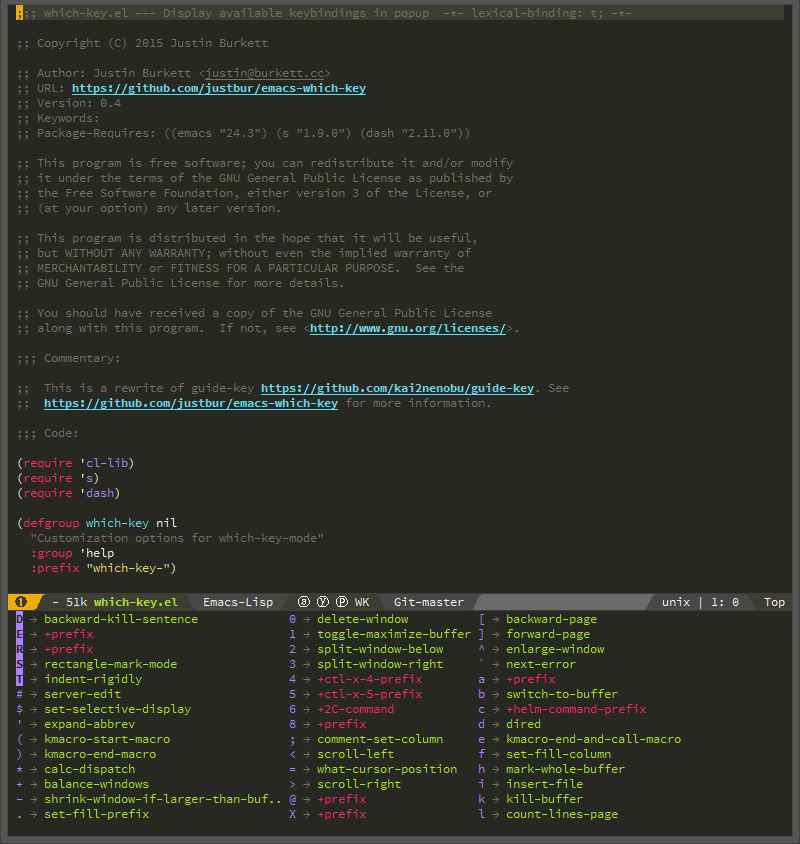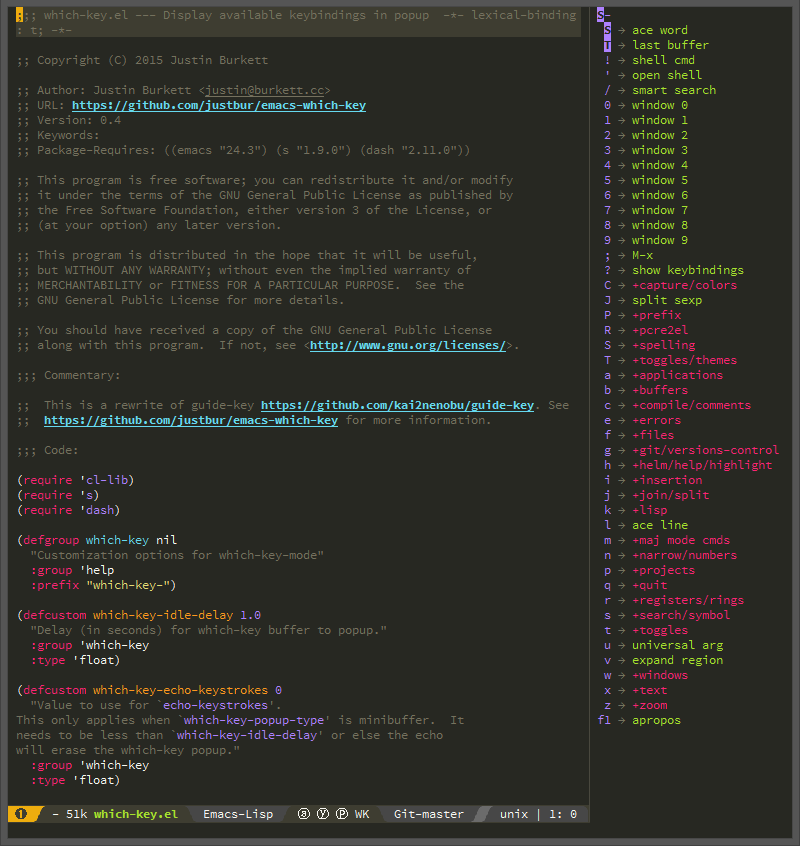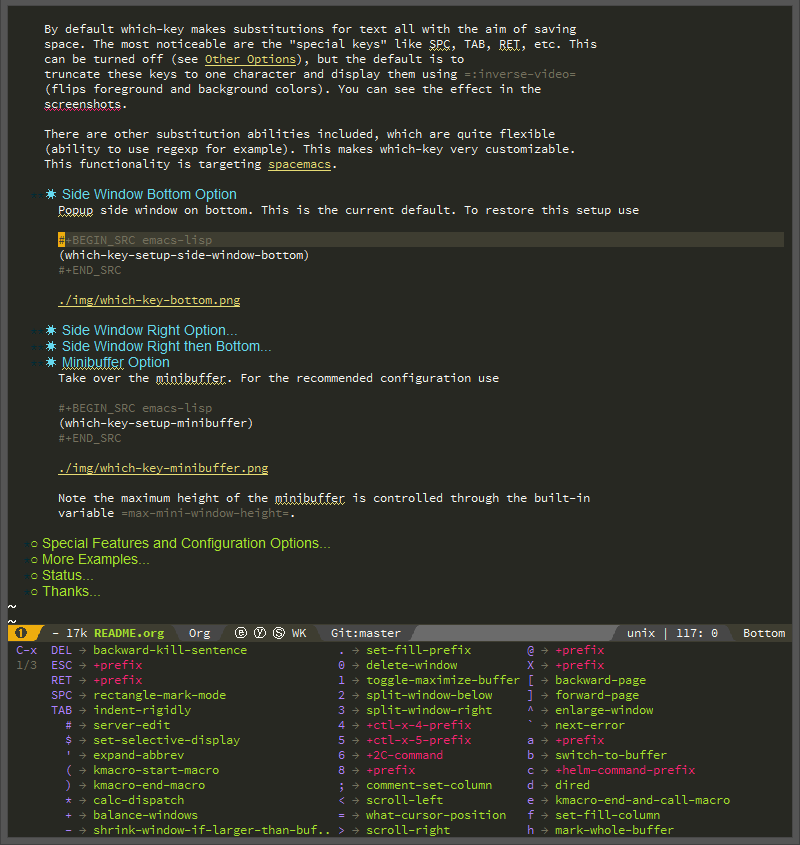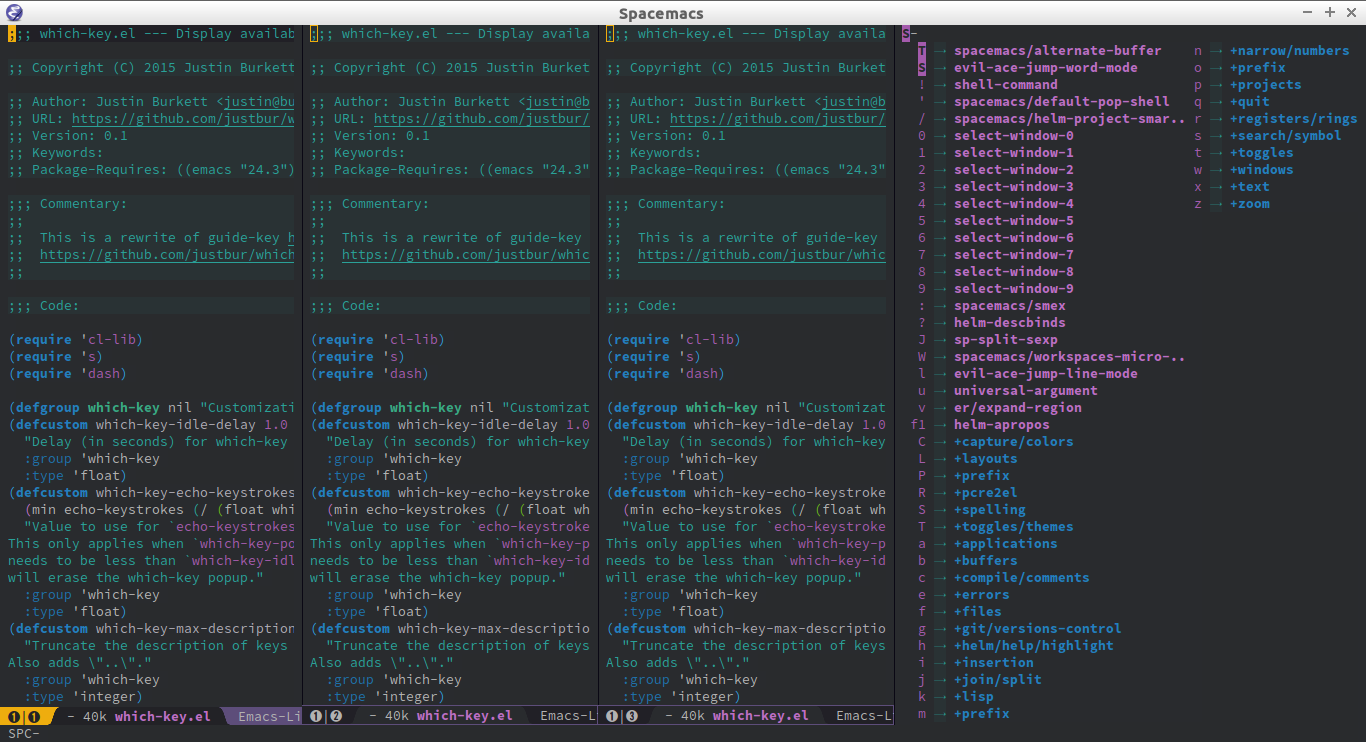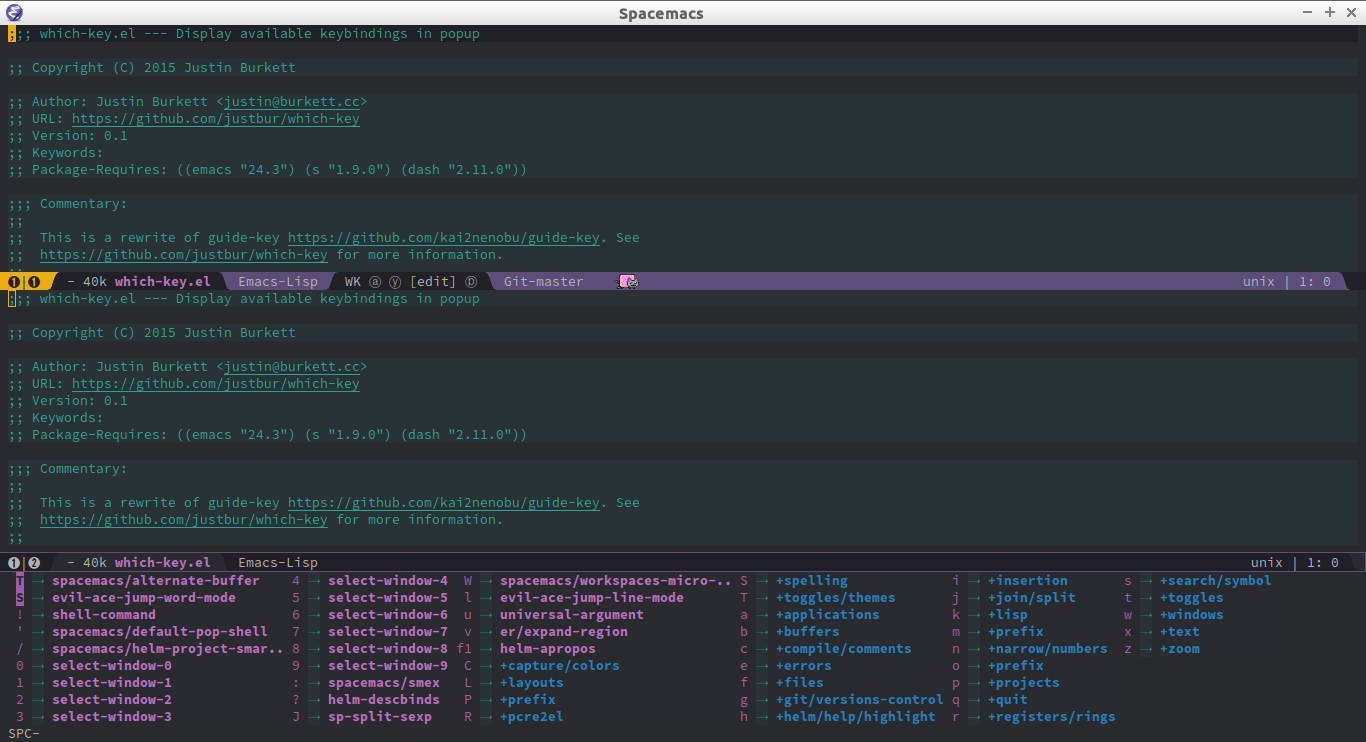which-key is a minor mode for Emacs that displays the key bindings following your currently
entered incomplete command (a prefix) in a popup. For example, after enabling the minor mode
if you enter C-x and wait for the default of 1 second the minibuffer will expand with all of
the available key bindings that follow C-x (or as many as space allows given your settings).
This includes prefixes like C-x 8 which are shown in a different face. Screenshots of what
the popup will look like are included below. which-key started as a rewrite of
guide-key-mode, but the feature sets have diverged
to a certain extent.
With respect to guide-key, the intention is to provide the
following features:
- A different polling mechanism to make it lighter on resources than guide-key
- An improved display of keys with more keys being shown by default and a nicer presentation
- Customization options that allow for the rewriting of command names on the fly through easily modifiable alists
- Good default configurations that work well with most themes
- A well configured back-end for displaying keys (removing the popwin dependency) that can be easily customized by writing new display functions
Many of these have been implemented and are described below.
- which-key
After setting up MELPA as a repository, use M-x package-install which-key or
your preferred method. You will need to call which-key-mode to enable the
minor mode of course.
Add which-key.el to your load-path and require. Something like
(add-to-list 'load-path "path/to/which-key.el")
(require 'which-key)
(which-key-mode)Which-key requires recent versions of the packages dash and s. These are installed automatically if installed via MELPA.
No further setup is required if you are happy with the default setup. To try other options, there are 3 choices of default configs that are preconfigured (then customize to your liking). The main choice is where you want the which-key buffer to display. Screenshots of the default options are shown in the next sections.
In each case, we show as many key bindings as we can fit in the buffer within the constraints. The constraints are determined by several factors, including your Emacs settings, the size of the current Emacs frame, and the which-key settings, most of which are described below.
By default which-key makes substitutions for text all with the aim of saving
space. The most noticeable are the “special keys” like SPC, TAB, RET, etc. This
can be turned off (see Other Options), but the default is to
truncate these keys to one character and display them using :inverse-video
(flips foreground and background colors). You can see the effect in the
screenshots.
There are other substitution abilities included, which are quite flexible (ability to use regexp for example). This makes which-key very customizable. This functionality is targeting spacEmacs.
Popup side window on bottom. This is the current default. To restore this setup use
(which-key-setup-side-window-bottom)Popup side window on right. For defaults use
(which-key-setup-side-window-right)Note the defaults are fairly conservative and will tend to not display on
narrower frames. If you get a message saying which-key can’t display the keys,
try making your frame wider or adjusting the defaults related to the maximum
width (see M-x customize-group which-key).
This is a combination of the previous two choices. It will try to use the right side, but if there is no room it will switch to using the bottom, which is usually easier to fit keys into. This setting can be helpful if the size of the Emacs frame changes frequently, which might be the case if you are using a dynamic/tiling window manager.
(which-key-setup-side-window-right-bottom)Take over the minibuffer. For the recommended configuration use
(which-key-setup-minibuffer)Note the maximum height of the minibuffer is controlled through the built-in
variable max-mini-window-height.
There are more options than the ones described here. All of the configurable
variables are available through M-x customize-group which-key.
There are three different popup types that which-key can use by default to
display the available keys. The variable which-key-popup-type decides which
one is used.
(setq which-key-popup-type 'minibuffer)Show keys in the minibuffer.
(setq which-key-popup-type 'side-window)Show keys in a side window. This popup type has further options:
;; location of which-key window. valid values: top, bottom, left, right,
;; or a list of any of the two. If it's a list, which-key will always try
;; the first location first. It will go to the second location if there is
;; not enough room to display any keys in the first location
(setq which-key-side-window-location 'bottom)
;; max width of which-key window, when displayed at left or right.
;; valid values: number of columns (integer), or percentage out of current
;; frame's width (float larger than 0 and smaller than 1)
(setq which-key-side-window-max-width 0.33)
;; max height of which-key window, when displayed at top or bottom.
;; valid values: number of lines (integer), or percentage out of current
;; frame's height (float larger than 0 and smaller than 1)
(setq which-key-side-window-max-height 0.25)(setq which-key-popup-type 'frame)Show keys in a popup frame. This popup won’t work very well in a terminal, where only one frame can be shown at any given moment. This popup type has further options:
;; max width of which-key frame: number of columns (an integer)
(setq which-key-frame-max-width 60)
;; max height of which-key frame: number of lines (an integer)
(setq which-key-frame-max-height 20)Write your own display functions! This requires you to write three functions,
which-key-custom-popup-max-dimensions-function,
which-key-custom-show-popup-function, and
which-key-custom-hide-popup-function. Refer to the documentation for those
variables for more information, but here is a working example (this is the
current implementation of side-window bottom).
(setq which-key-popup-type 'custom)
(defun which-key-custom-popup-max-dimensions-function (ignore)
(cons
(which-key-height-or-percentage-to-height which-key-side-window-max-height)
(frame-width)))
(defun fit-horizonatally ()
(let ((fit-window-to-buffer-horizontally t))
(fit-window-to-buffer)))
(defun which-key-custom-show-popup-function (act-popup-dim)
(let* ((alist '((window-width . fit-horizontally)
(window-height . fit-window-to-buffer))))
(if (get-buffer-window which-key--buffer)
(display-buffer-reuse-window which-key--buffer alist)
(display-buffer-in-major-side-window which-key--buffer 'bottom 0 alist))))
(defun which-key-custom-hide-popup-function ()
(when (buffer-live-p which-key--buffer)
(quit-windows-on which-key--buffer)))You can customize the way the keys show in the buffer using three different
replacement methods, each of which corresponds replacement alist. The basic idea
of behind each alist is that you specify a selection string in the car of each
cons cell and the replacement string in the cdr.
[Note on 2015-9-3 the format of
which-key-key-based-description-replacement-alist changed. It will be easier
to use the functions below in your configuration, instead of modifying this
variable directly.]
Using this method, the description of a key is replaced using a string that you provide. Here’s an example
(which-key-add-key-based-replacements
"C-x C-f" "find files")where the first string is the key combination whose description you want to
replace, in a form suitable for kbd. For that key combination, which-key
overwrites the description with the second string, “find files”. In the second
type of entry you can restrict the replacements to a major-mode. For example,
(which-key-add-major-mode-key-based-replacements 'org-mode
"C-c C-c" "Org C-c C-c"
"C-c C-a" "Org Attach")Here the first entry is the major-mode followed by a list of the first type of entries. In case the same key combination is listed under a major-mode and by itself, the major-mode version takes precedence.
The second and third methods target the text used for the keys and the
descriptions directly. The relevant variables are
which-key-key-replacement-alist and which-key-description-replacement-alist.
Here’s an example of one of the default key replacements
("<\\([[:alnum:]-]+\\)>" . "\\1")The car takes a string which may use Emacs regexp and the cdr takes a string
with the replacement text. As shown, you can specify a sub-expression of the
match. The replacements do not need to use regexp and can be as simple as
("left" . "lft")You can add this element to the key list with (there are no helper functions for these alists)
(add-to-list 'which-key-key-replacement-alist '("left" . "lft"))By default the output is sorted by the key in a custom order. The default order is to sort lexicographically within each “class” of key, where the classes and their order are
Special (SPC, TAB, ...) < Single Character (a, ...) < Modifier (C-, M-, ...) < Other
You can control the order by setting this variable.
(setq which-key-sort-order 'which-key-key-order)
;; or (setq which-key-sort-order 'which-key-description-order)The only other built-in option at the moment (besides using nil to turn off
sorting completely) is which-key-description-order, which orders by the key’s
description based on the usual ordering of strings after applying downcase.
There are at least several prefixes that have many keys bound to them, like
C-x. which-key displays as many keys as it can given your settings, but for
these prefixes this may not be enough. The paging feature gives you the ability
to bind a key to the function which-key-show-next-page which will cycle
through the pages without changing the key sequence you were in the middle of
typing. There are two slightly different ways of doing this.
This is the easiest way, and is turned on by default. Use
(setq which-key-use-C-h-for-paging nil)to disable the behavior (this will only take effect after toggling
which-key-mode if it is already enabled). C-h can be used with any prefix to
switch pages when there are multiple pages of keys. This changes the default
behavior of Emacs which is to show a list of key bindings that apply to a prefix.
For example, if you were to type C-x C-h you would get a list of commands that
follow C-x. This uses which-key instead to show those keys, and unlike the
Emacs default saves the incomplete prefix that you just entered so that the next
keystroke can complete the command. As a bonus you can type C-x C-h and the
which-key buffer will pop up immediately (i.e., before which-key-idle-delay
kicks in).
The option which-key-prevent-C-h-from-cycling, which is t by default
allows one to take advantage of using C-h for paging as well as the default
Emacs behavior of using C-h to describe the bindings for the current key
sequence prefix.
The default configuration below will allow you to switch paging using C-h
until you reach the last page of keys in the which-key buffer. The next press of
C-h will close the which-key buffer and trigger the default Emacs behavior on
C-h.
(setq which-key-use-C-h-for-paging t
which-key-prevent-C-h-from-cycling t)This is especially useful for those who like helm-descbinds but also want to
use C-h as their which-key paging key.
Note C-h is by default equivalent to ? in this context.
Essentially, all you need to do for a prefix like C-x is the following which
will bind <f5> to the relevant command.
(define-key which-key-mode-map (kbd "C-x <f5>") 'which-key-show-next-page)This is completely equivalent to
(setq which-key-paging-prefixes '("C-x"))
(setq which-key-paging-key "<f5>")where the latter are provided for convenience if you have a lot of prefixes.
The faces that which-key uses are
| Face | Applied To | Default Definition |
|---|---|---|
which-key-key-face | Every key sequence | :inherit font-lock-constant-face |
which-key-separator-face | The separator (→) | :inherit font-lock-comment-face |
which-key-note-face | Hints and notes | :inherit which-key-separator-face |
which-key-special-key-face | User-defined special keys | :inherit which-key-key-face :inverse-video t :weight bold |
which-key-group-description-face | Command groups (i.e, keymaps) | :inherit font-lock-keyword-face |
which-key-command-description-face | Commands not in local-map | :inherit font-lock-function-name-face |
which-key-local-map-description-face | Commands in local-map | :inherit which-key-command-description-face |
The last two deserve some explanation. A command lives in one of many possible
keymaps. You can distinguish between local maps, which depend on the buffer you
are in, which modes are active, etc., and the global map which applies
everywhere. It might be useful for you to distinguish between the two. One way
to do this is to remove the default face from
which-key-command-description-face like this
(set-face-attribute 'which-key-command-description-face nil :inherit nil)another is to make the local map keys appear in bold
(set-face-attribute 'which-key-local-map-description-face nil :weight 'bold)You can also use M-x customize-face to customize any of the above faces to
your liking.
The options below are also available through customize. Their defaults are shown.
;; Set the time delay (in seconds) for the which-key popup to appear.
(setq which-key-idle-delay 1.0)
;; Set the maximum length (in characters) for key descriptions (commands or
;; prefixes). Descriptions that are longer are truncated and have ".." added
(setq which-key-max-description-length 27)
;; Set the separator used between keys and descriptions. Change this setting to
;; an ASCII character if your font does not show the default arrow. The second
;; setting here allows for extra padding for Unicode characters. which-key uses
;; characters as a means of width measurement, so wide Unicode characters can
;; throw off the calculation.
(setq which-key-separator " → " )
(setq which-key-unicode-correction 3)
;; Set the special keys. These are automatically truncated to one character and
;; have which-key-special-key-face applied. Set this variable to nil to disable
;; the feature
(setq which-key-special-keys '("SPC" "TAB" "RET" "ESC" "DEL"))
;; Show the key prefix on the left or top (nil means hide the prefix). The
;; prefix consists of the keys you have typed so far. which-key also shows the
;; page information along with the prefix.
(setq which-key-show-prefix 'left)
;; Set to t to show the count of keys shown vs. total keys in the mode line.
(setq which-key-show-remaining-keys nil)Unlike guide-key, which-key looks good even if the frame is split into several windows.
It requires testing on different platforms with different configurations, which is beyond my capabilities. The default configuration has been reasonably stable for me.
Thanks to @bmag for helping with the initial development and finding many bugs.
